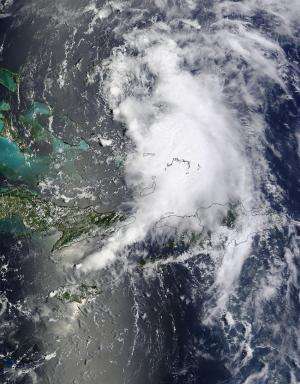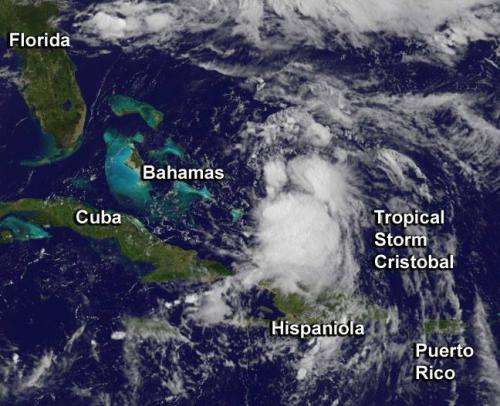Satellites capture the birth and movement of Tropical Storm Cristobal

The third tropical storm of the Atlantic hurricane season formed near the southeastern Bahamas on Sunday, August 24. NASA's Aqua satellite and NOAA's GOES-East satellites provided imagery of the storm's birth and movement.
System 96L lingered in the eastern Caribbean over the last couple of days and on Saturday, August 23, became a tropical depression. That depression strengthened into a tropical storm during the morning of August 24. A GOES-East satellite image was taken at 9:30 a.m. EDT on August 24 showed Cristobal as a rounded area of clouds north of Hispaniola (Haiti and the Dominican Republic) moving into the southeastern Bahamas. The GOES image was created at NASA's GOES Project office in NASA's Goddard Space Flight Center in Greenbelt, Maryland.
Upon its birth Cristobal had sparked Tropical Storm Warnings for Southeastern Bahamas, Including the Acklins, Crooked Island, Long Cay, the Inaguas, Mayaguana, the Ragged Islands, as well as the Turks and Caicos Islands, Central Bahamas, Including Cat Island, The Exumas, Long Island, Rum Cay, and San Salvador.
At 8 a.m. EDT on August 24, Cristobal's maximum sustained winds were near 45 mph (75 kph). The center of Tropical Storm Cristobal was located near latitude 23.0 north and longitude 73.0 west. That put the center just 40 miles (60 km) north of Mayaguana Island. A day later, Monday, August 24, Cristobal was still dropping heavy rainfall over the Turks and Caicos Islands as it moved slowly and erratically to the north-northeast.
Heavy rainfall is a problem for the islands because Cristobal is moving so slowly. The National Hurricane Center noted that the tropical storm is expected to produce rainfall totals of 4 to 8 inches over the Turks and Caicos as well as portions of the southeastern and central Bahamas through Tuesday, with isolated amounts around 12 inches possible. Minor flooding was already reported during the morning of August 25 near Pirates Cove on Mayaguana Island.

On August 24 at 15:55 UTC (11:55 a.m. EDT) Cristobal's center appeared near Turks and Caicos Islands in this visible image from the Moderate Imaging Resolution Spectroradiometer (MODIS) instrument aboard NASA's Terra satellite. In the MODIS image, it appeared that northerly wind shear was affecting the storm, blowing most of the strongest clouds and thunderstorms south of the center.
By August 25, the wind shear had not let up. The National Hurricane Center described the storm as remaining sheared with the low-level center fully exposed on the north side of the "deep convective cloud mass (the area of the strongest thunderstorms)."
At 11 a.m. EDT (1500 UTC) Cristobal was centered about 120 miles (195 km) east-northeast of San Salvador Island, Bahamas, and 715 miles (1,150 km) southwest of Bermuda. That puts the center of Tropical Storm Cristobel near latitude 24.6 north and longitude 72.7 west. Cristobal's maximum sustained winds were near 60 mph (95 kph) and some strengthening is expected over the next two days. Cristobal is moving toward the north-northeast near 2 mph (4 kph) and is expected to turn northeast and speed up on Tuesday.
The government of Bahamas has discontinued the tropical storm warning for the central Bahamas.
The National Hurricane Center noted that a strong, elongated area of low pressure (a trough) just of the U.S. east coast is forecast to capture Cristobal and gradually lift out the cyclone to the northeast.
Provided by NASA's Goddard Space Flight Center





















